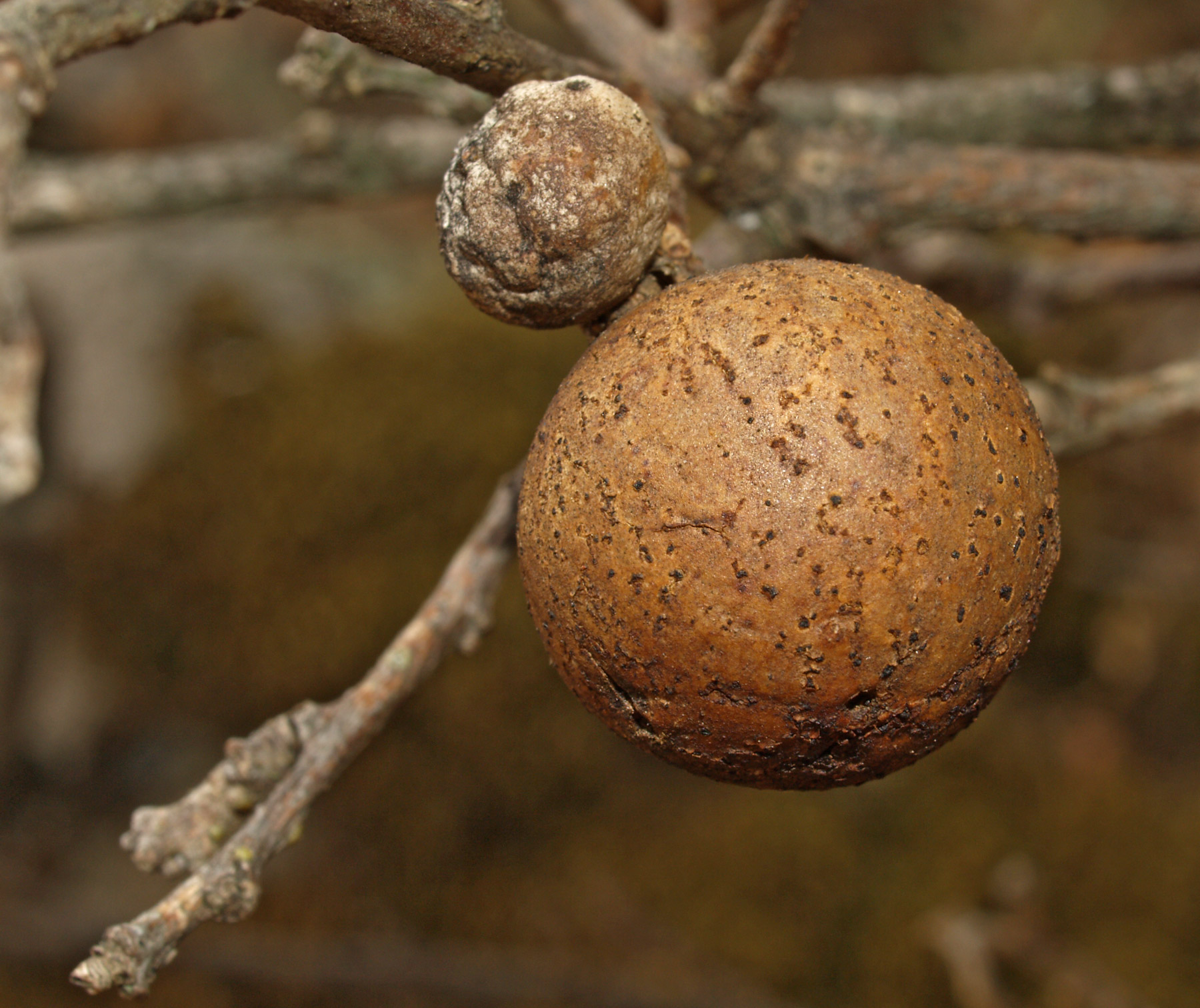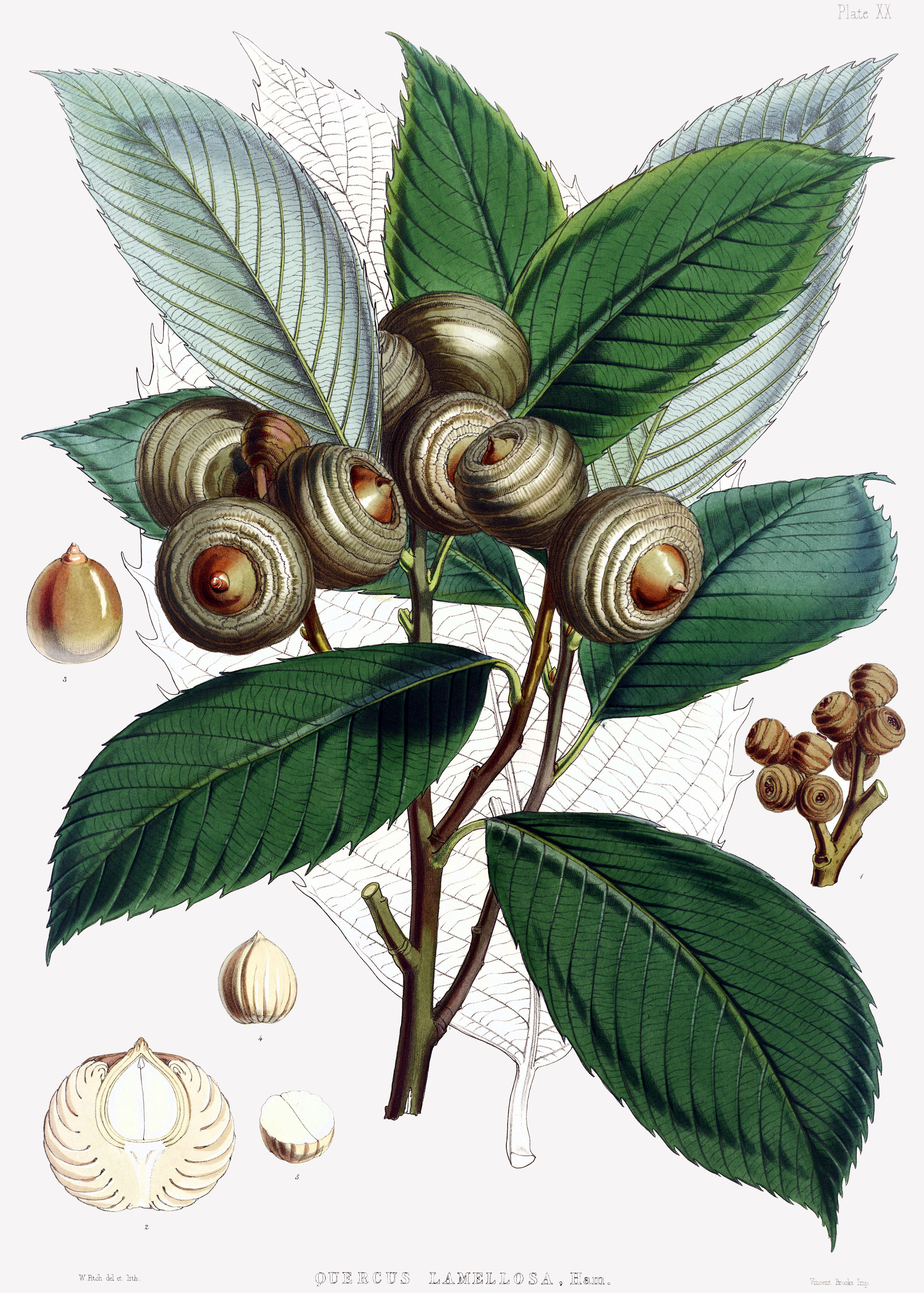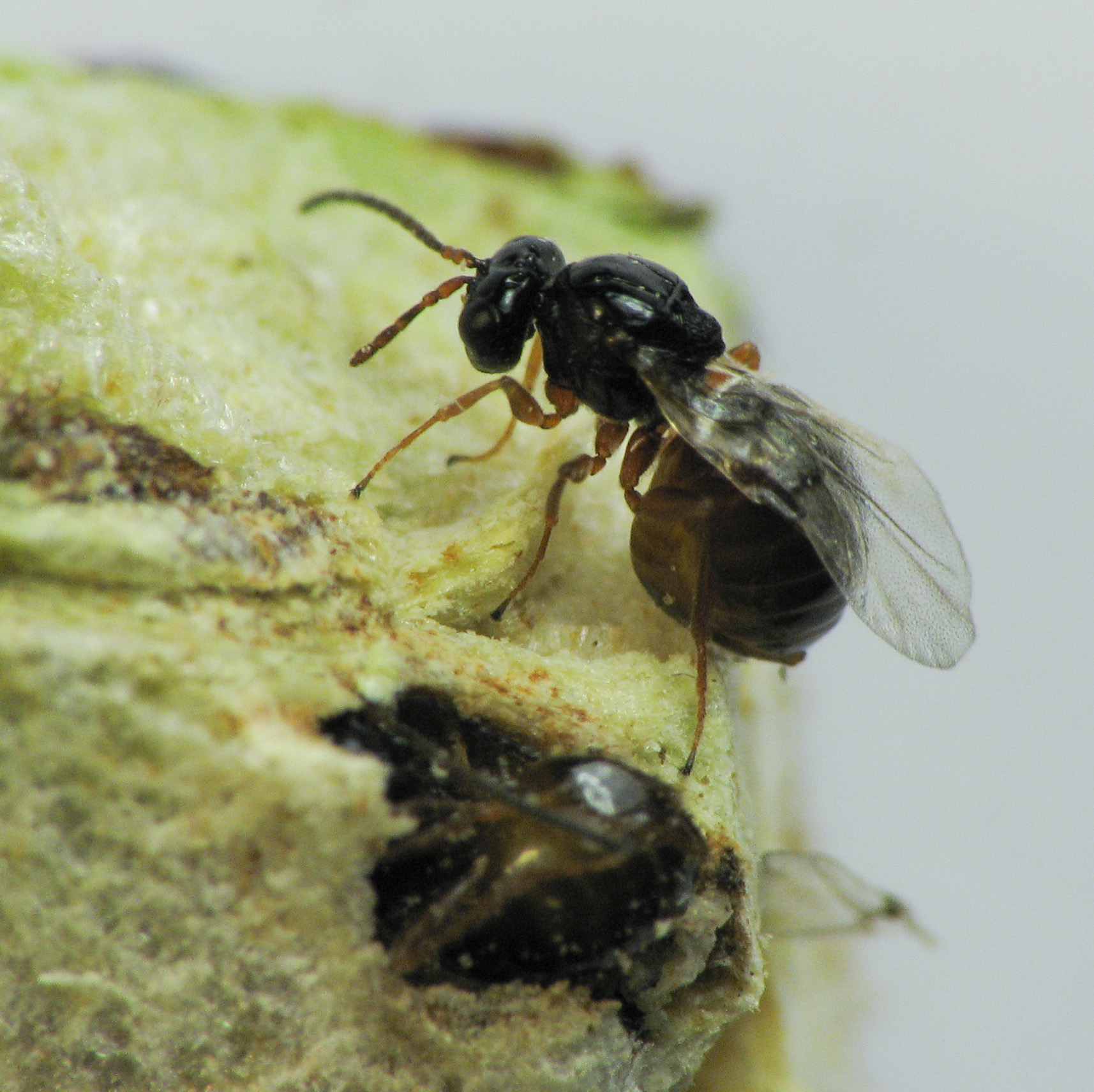|
Feron Pattersonae
''Feron pattersonae'', also known as the plate gall wasp, is a species of oak gall wasp in the genus '' Feron.'' Their hosts are among the white oaks grouping of oaks, with blue oak being common. Like most oak gall wasps, the plate gall wasp has two alternating generations a year: a parthenogenic all-female generation, and a bisexual generation. The all-female generation produces galls in summer that are flat and circular with scalloped edges. Attached to the underside of leaves, these galls are initially green, then yellow, and fade to brown. They are 7–9 mm in diameter and have a single larval chamber. The bisexual generation's galls were thought by scientist Alfred Kinsey Alfred Charles Kinsey (; June 23, 1894 – August 25, 1956) was an American sexologist, biologist, and professor of entomology and zoology who, in 1947, founded the Institute for Sex Research at Indiana University, now known as the Kinsey Insti ... in 1922 to belong to a new species, ''Andricus ... [...More Info...] [...Related Items...] OR: [Wikipedia] [Google] [Baidu] |
Cynipini
Cynipini is a tribe (biology), tribe of gall wasps. These insects induce galls in plants of the beech and oak family, Fagaceae. They are known commonly as the oak gall wasps.Melika, G., et al. (2013)A new genus of oak gallwasp, ''Cyclocynips'' Melika, Tang & Sinclair (Hymenoptera: Cynipidae: Cynipini), with descriptions of two new species from Taiwan.''Zootaxa'' 3630(3), 534-48. It is the largest cynipid tribe, with about 936Medianero, E. and J. L. Nieves-Aldrey. (2013)''Barucynips panamensis'', a new genus and species of oak gallwasps (Hymenoptera, Cynipidae, Cynipini) from Panama, and description of one new species of ''Coffeikokkos''.''ZooKeys'' (277), 25-46. to 1000 recognized species, most of which are associated with oaks. The tribe is mainly native to the Holarctic. Cynipini wasps can act as ecosystem engineers. Their galls can become hosts of inquilines, and the wasps themselves are hosts to parasitoids. Most of these wasps undergo cyclical parthenogenesis, sometimes repr ... [...More Info...] [...Related Items...] OR: [Wikipedia] [Google] [Baidu] |
Feron (wasp)
''Feron'' is a genus of Cynipini, oak gall wasps in the Nearctic realm, Nearctic. It was established by Alfred Kinsey in 1937, then re-established in 2023. Species The following species are grouped into ''Feron'': * ''Feron albicomus'' (Weld, 1952) * ''Feron amphorus'' (Weld, 1926) *''Feron apiarium'' (Weld, 1944) *''Feron atrimentum'' (Kinsey, 1922) *''Feron bakkeri'' (Lyon, 1984) *''Feron caepula'' (Weld, 1926) *''Feron californicum'' (Beutenmueller, 1911) *''Feron clarkei'' (Bassett, 1890) *''Feron comatum'' (Weld, 1952) *''Feron crystallinum'' (Bassett, 1900) *''Feron cylindratum'' (Kinsey, 1937) *''Feron discale'' (Weld, 1926) *''Feron discularis'' (Weld, 1926) *''Feron dumosae'' (Weld, 1957) *''Feron gigas'' (Kinsey, 1922) *''Feron izabellae'' (Melika, Nicholls & Stone) *''Feron kingi'' (Bassett, 1900) *''Feron parmula'' (Bassett, 1900) *''Feron pattersonae'' (Fullaway, 1911) *''Feron roberti'' (Melika, Nicholls & Stone) *''Feron rucklei'' (Melika, Nicholls & Stone) *'' ... [...More Info...] [...Related Items...] OR: [Wikipedia] [Google] [Baidu] |
List Of Quercus Species
The genus ''Quercus'' contains about 500 known species, plus about 180 hybrids between them. The genus, as is the case with many large genera, is divided into subgenera and sections. Traditionally, the genus ''Quercus'' was divided into the two subgenera ''Cyclobalanopsis'', the ring-cupped oaks, and ''Quercus'', which included all the other sections. However, a comprehensive revision in 2017 identified different relationships. Now the genus is commonly divided into a subgenus ''Quercus'' and a subgenus ''Cerris'', with ''Cyclobalanopsis'' included in the latter. The sections of subgenus ''Quercus'' are mostly native to the New World, with the notable exception of the white oaks of sect. ''Quercus'' and the endemic '' Quercus pontica''. In contrast, the sections of the subgenus ''Cerris'' are exclusively native to the Old World. Unless otherwise indicated, the lists which follow contain all the species accepted by Plants of the World Online , plus selected hybrids that are also ... [...More Info...] [...Related Items...] OR: [Wikipedia] [Google] [Baidu] |
Quercus Douglasii
''Quercus douglasii'', known as blue oak, is a species of oak endemic to California, common in the Coast Ranges and the foothills of the Sierra Nevada. It is California's most drought-tolerant deciduous oak, and is a dominant species in the blue oak woodland ecosystem. It is occasionally known as mountain oak and iron oak. Description ''Quercus douglasii'' is a medium-sized tree with sparse foliage, generally tall, with a trunk in diameter at breast height. Trunks are typically solitary, but some trees have multiple trunks. The tallest recorded specimen was found in Alameda County, at . The trees grow slowly, about per year. Individual trees over 500 years old have been recorded. The bark is light gray with many medium-sized dark cracks. The blue-green leaves are tough and leathery, deciduous, long, and entire or shallowly lobed. The acorns are long, with a moderately sweet kernel, and mature in 6–7 months from pollination. ''Q. douglasii'' is monoecious and wind-po ... [...More Info...] [...Related Items...] OR: [Wikipedia] [Google] [Baidu] |
Princeton University Press
Princeton University Press is an independent publisher with close connections to Princeton University. Its mission is to disseminate scholarship within academia and society at large. The press was founded by Whitney Darrow, with the financial support of Charles Scribner, as a printing press to serve the Princeton community in 1905. Its distinctive building was constructed in 1911 on William Street in Princeton. Its first book was a new 1912 edition of John Witherspoon's ''Lectures on Moral Philosophy.'' History Princeton University Press was founded in 1905 by a recent Princeton graduate, Whitney Darrow, with financial support from another Princetonian, Charles Scribner II. Darrow and Scribner purchased the equipment and assumed the operations of two already existing local publishers, that of the ''Princeton Alumni Weekly'' and the Princeton Press. The new press printed both local newspapers, university documents, '' The Daily Princetonian'', and later added book publishing ... [...More Info...] [...Related Items...] OR: [Wikipedia] [Google] [Baidu] |
Stanford University Press
Stanford University Press (SUP) is the publishing house of Stanford University. It is one of the oldest academic presses in the United States and the first university press to be established on the West Coast. It is currently a member of the Association of University Presses. The press publishes 130 books per year across the humanities, social sciences, and business, and has more than 3,500 titles in print. History David Starr Jordan, the first president of Stanford University, posited four propositions to Leland and Jane Stanford when accepting the post, the last of which stipulated, "That provision be made for the publication of the results of any important research on the part of professors, or advanced students. Such papers may be issued from time to time as 'Memoirs of the Leland Stanford Junior University.'" In 1892, the first work of scholarship to be published under the Stanford name, ''The Tariff Controversy in the United States, 1789-1833'', by Orrin Leslie Elliott, ... [...More Info...] [...Related Items...] OR: [Wikipedia] [Google] [Baidu] |
Feron Pattersonae Spring Gall
Fafnir Falcon Falcona Falligar the Behemoth Falligar the Behemoth, also known simply as Falligar, is a fictional character appearing in American comic books published by Marvel Comics. He makes a single appearance in '' Thor: God of Thunder'' #3 (December 2012). Falligar is a fictional deity who appears as one of the victims of Gorr the God Butcher, who killed Falligar and left his corpse rotting on the shores of his home planet, with his worshipers surrounding him and praying for his resurrection. Falligar the Behemoth in other media Falligar's corpse appears in '' Thor: Love and Thunder''. Famine Famine is the name of several characters appearing in American comic books published by Marvel Comics, usually as one of the Horsemen of Apocalypse. Autumn Rolfson Roderick Campbell Jeb Lee Shiro Yoshida Famine (First Horseman of Apocalypse) Famine is the one of four children of Apocalypse and Genesis, born and raised on Okkara. He and his siblings grow up to be the f ... [...More Info...] [...Related Items...] OR: [Wikipedia] [Google] [Baidu] |
Parthenogenesis
Parthenogenesis (; from the Greek + ) is a natural form of asexual reproduction in which the embryo develops directly from an egg without need for fertilization. In animals, parthenogenesis means the development of an embryo from an unfertilized Gametophyte, egg cell. In plants, parthenogenesis is a component process of apomixis. In algae, parthenogenesis can mean the development of an embryo from either an individual sperm or an individual egg. Parthenogenesis occurs naturally in some plants, algae, invertebrate animal species (including nematodes, some tardigrades, water fleas, some scorpions, aphids, some mites, some bees, some Phasmatodea, and parasitic wasps), and a few vertebrates, such as some fish, amphibians, and reptiles. This type of reproduction has been induced artificially in animal species that naturally reproduce through sex, including fish, amphibians, and mice. Normal egg cells form in the process of meiosis and are haploid, with half as many chromosomes as t ... [...More Info...] [...Related Items...] OR: [Wikipedia] [Google] [Baidu] |
Alfred Kinsey
Alfred Charles Kinsey (; June 23, 1894 – August 25, 1956) was an American sexologist, biologist, and professor of entomology and zoology who, in 1947, founded the Institute for Sex Research at Indiana University, now known as the Kinsey Institute for Research in Sex, Gender, and Reproduction. He is best known for writing ''Sexual Behavior in the Human Male'' (1948) and ''Sexual Behavior in the Human Female'' (1953), also known as the Kinsey Reports, as well as for the Kinsey scale. Kinsey's research on human sexuality, foundational to the field of sexology, provoked controversy in the 1940s and 1950s, and has continued to provoke controversy decades after his death. His work has influenced social and cultural values in the United States as well as internationally. Early life and education Alfred Kinsey was born on June 23, 1894, in Hoboken, New Jersey, the son of Sarah Ann ( Charles) and Alfred Seguine Kinsey. He was the eldest of three children. His mother received little f ... [...More Info...] [...Related Items...] OR: [Wikipedia] [Google] [Baidu] |
Cynipidae
Gall wasps, also wikt:gallfly#Usage notes, traditionally called gallflies, are hymenopterans of the family Cynipidae in the wasp superfamily Cynipoidea. Their common name comes from the galls they induce on plants for larval development. About 1,300 species of this generally very small creature () are known worldwide, with about 360 species of 36 different genera in Europe and some 800 species in North America. Features Like all Apocrita, gall wasps have a distinctive body shape, the so-called Petiole (insect anatomy), wasp waist. The first abdominal tergum (the propodeum) is conjoined with the Thorax (insect anatomy), thorax, while the second abdominal segment forms a sort of shaft, the Petiole (insect anatomy), petiole. The petiole connects with the gaster (insect anatomy), gaster, which is the functional abdomen in apocritan wasps, starting with the third abdominal segment proper. Together, the petiole and the gaster form the metasoma, while the thorax and the propodeum mak ... [...More Info...] [...Related Items...] OR: [Wikipedia] [Google] [Baidu] |
Oak Galls
An oak apple or oak gall is a large, round, vaguely apple-like gall commonly found on many species of oak. Oak apples range in size from in diameter and are caused by chemicals injected by the larva of certain kinds of gall wasp in the family Cynipidae. Formation The adult female wasp lays single eggs in developing leaf buds. The wasp larvae feed on the gall Tissue (biology), tissue resulting from their secretions, which modify the oak bud into the gall, a structure that protects the developing larvae until they undergo metamorphosis into adults. Some common oak-apple-forming species are the ''Biorhiza pallida'' gall wasp in Europe, ''Amphibolips confluenta'' in eastern North America, and ''Atrusca bella'' in western North America. Oak apples may be brownish, yellowish, greenish, pinkish, or reddish. Other galls Considerable confusion exists in the general literature between the oak apple and the Andricus kollari, oak marble gall. The oak marble is frequently called the o ... [...More Info...] [...Related Items...] OR: [Wikipedia] [Google] [Baidu] |









